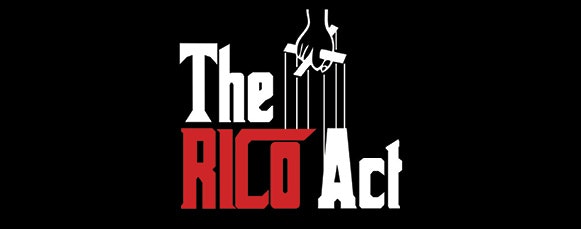How Authorities Use RICO Laws to Attack Leftists

For completely nonsensical reasons, the state of Georgia is charging 61 people at the Cop City protests with racketeering charges under RICO laws. The irony of using a charge intended to stop the relationship between organized crimes and businesses is pretty clear, but the state doesn’t care. In fact, RICO charges get used against unions repeatedly. I know several union people have had to testify on spurious RICO charges. It’s just another way to desecrate the law in order to bust radicals, or even not radicals but anyone left of center the state/corporate alliance doesn’t like. You don’t have to approve of the protests (I largely do approve of them, except for the anarchist philosophy at their heart which I think leads to a dead end, but whatever, they are on the ground trying to stop this abomination so go for it young anarchists!) to think of this as a complete miscarriage of justice.
What’s up with these laws being used against radicals anyway? Dan Berger has a good rundown at the Radical History Review blog about how this has developed over time:
While the charges against the Stop Cop City activists will rightly strike many as both outlandish and terrifying, RICO has a long history of being used as an expansive assault on leftwing radicals. Take the case of Ray Luc Levasseur, whose experience and insight offer a window into RICO suppression. From a working-class Quebecois family in Maine, Levasseur followed in his family’s footsteps—first into the woolen mills and shoe factories of Maine and then by joining the US Army. He was sent to Vietnam in 1967. What he saw there outraged him. “After Vietnam,” Levasseur later said, “I asked the most seditious question of all: why? Why is this government committing crimes in our name? Why were so many of us from poor and working-class backgrounds; why so many Black and Latino GIs over there told to do the killing and the fighting while the kids who have the money are going to the good schools in the United States? I wasn’t coming back to a university. I was going to come back and face the prospect of going back and making some more heels for those shoes.” Upon his return to the United States, Levassuer joined the Southern Student Organizing Committee in Tennessee. He received a five-year prison sentence in 1969 for selling seven dollars of marijuana.
When he got out, he returned to Maine, where he worked with Vietnam Veterans Against the War and the Statewide Correctional Alliance for Reform (SCAR). The group worked with both currently and formerly incarcerated people. Among other things, SCAR operated a bail fund and was loosely affiliated with a radical bookstore called Red Star North. (Among the factors precipitating the state’s allegation that Stop Cop City is a criminal conspiracy is the Atlanta Solidarity bail fund and the circulation of radical zines.) The bookstore was a frequent target of attack. After Levasseur learned of a police death squad aimed to kill him and fellow SCAR member Tom Manning, he and his comrades went underground. They soon found themselves on the FBI’s Ten Most Wanted list, accused of participating in a string of bombings by a group calling itself either the Sam Melville/Jonathan Jackson Unit or the United Freedom Front. The bombings, which targeted government or corporate buildings, were meant to protest US support for apartheid, Central American death squads, and police violence in the United States.
Levasseur, Patricia Gros Levasseur, Jaan Laaman, Barbara Curzi Laaman, and Richard Williams were arrested in Ohio in November 1984. Six months later, police arrested Tom and Carol Saucier Manning. The Laamans, Levasseurs, and Mannings each had three kids, all of whom were arrested along with their parents. Police not only separated the parents from their children but tried to coerce the children—all of whom were minors—to snitch against their parents. According to statements at the time from the captured revolutionaries, police offered Carmen Levasseur, then 8 years old, $20 and a pizza to provide information. The Mannings, meanwhile, were not allowed to communicate with or even to know the whereabouts of their children for eight weeks. The Laaman children were incarcerated for six weeks, during which time they were interrogated.
By 1986, the “Ohio 7,” as they were known, faced dozens of charges stemming from their political activity while underground. Because their respective husbands were wanted by police, Curzi, Gros, and Saucier were initially charged with “harboring a fugitive.” Those charges were dropped when the government secured lengthy sentences, cumulatively totaling hundreds of years, stemming from their other underground activities. Yet the government also pursued RICO and seditious conspiracy charges against them. In 1989, after assorted machinations, the federal government prosecuted Levasseur, Gross, and Williams again for seditious conspiracy and RICO violations. In essence, the trio was accused of pursuing a criminal plot to overthrow the government by force. Theirs was one of several examples in the 1980s of the government using catch-all conspiracy charges to target leftwing groups, including Puerto Rican independence activists and Black revolutionaries. Another group of white anti-imperialists, the so-called Resistance Conspiracy, also faced the charge.
To the radicals on trial, the RICO charge was particularly noxious. It allowed the government to tack on charges. Worse, it rendered political activity criminal. In his opening statement, Levasseur, who represented himself, accused the government of bending language and the law. “You cannot be a revolutionary and a racketeer,” he averred. “It’s a contradiction. It is either one or the other.” After the longest and most expensive trial in Massachusetts history, Levasseur, Gross, and Williams were acquitted of sedition. When the jury deadlocked on the RICO charges, the judge dismissed them. The government declined to appeal.


